|
|
| |
|
|
|
|
|
|
|
|
|
|
|
| | |||||||||||
| |
|
|||||||||||
|
State
Estimates of Substance Use and Mental Health from the |
|
|
In 2005 and 2006, serious psychological distress (SPD) was measured using the "short-form" module consisting only of the K6 screening instrument for nonspecific psychological distress (Kessler et al., 2003). In the 2004 National Survey on Drug Use and Health (NSDUH), the sample of respondents aged 18 or older was split evenly between the "long-form" module, which included all items in the mental health module used in the 2003 NSDUH (sample A), and a "short-form" module consisting only of the K6 items (sample B). In order to produce the pooled 2004-2005 SPD estimates, the 2004 sample A "long-form" scores were transformed to match the distributional characteristics of the 2004 sample B "short-form" scores using the cumulative distribution function (CDF) adjustment method described in Appendix A of this report (Section A.8). These adjusted 2004 sample A scores were used in conjunction with the 2004 sample B "short-form" scores and the 2005 "short-form" SPD scores to produce the 2004-2005 SPD estimates. The SPD estimates in the 2003-2004 small area estimation (SAE) report and other prior SAE reports are, therefore, not comparable with the 2004-2005 and 2005-2006 SPD estimates in this report.
In 2005-2006, SPD was present in 11.3 percent of the population aged 18 or older (Table B.23). Utah had the highest rate of SPD in the past year among persons aged 18 or older (14.4 percent), while Hawaii had the lowest rate (8.8 percent). Four States (Arkansas, Missouri, Rhode Island, and Utah) were in the top fifth for both age groups (18 to 25 and 26 or older) and among all persons 18 or older (Figures 6.1 to 6.3). Eight States showed significant declines in SPD between 2004-2005 and 2005-2006 among young adults aged 18 to 25 (Arizona, Louisiana, Massachusetts, New Jersey, New York, Ohio, Oklahoma, and Washington) (Table C.23). These decreases at the State level contributed to the national decrease in SPD rates among young adults aged 18 to 25 from 19.4 to 18.1 percent. No significant increases in SPD occurred in any State or age group.
Beginning in 2004, a module was included in the NSDUH questionnaire that was related to having a major depressive episode (MDE); it was derived from the criteria specified for major depression in the Diagnostic and Statistical Manual of Mental Disorders, 4th edition (DSM-IV) (American Psychiatric Association [APA], 1994). These questions permit estimates to be calculated for lifetime and past year prevalence of MDE, treatment for MDE, and role impairment resulting from MDE. For this report, estimates were produced only for having MDE in the past year.
In 2004, a split-sample design was implemented where adults aged 18 or older in half of the sample (sample B) received the depression module while adult respondents in the other half (sample A) did not. All youths aged 12 to 17 were administered the adolescent depression module. In 2005 and 2006, however, all adult and adolescent respondents were administered their respective depression modules. Due to minor wording differences in the questions in the adult and adolescent MDE modules, data from youths aged 12 to 17 were not combined with data from persons aged 18 or older to get an overall estimate for those aged 12 or older. Instead, an estimate for those aged 18 or older was produced. To produce the pooled 2004-2005 MDE estimates, the 2005 MDE data were pooled with the 2004 sample B MDE data. Because the 2004 sample A was not used in the estimation process, the 2004 sample B weights were properly adjusted to account for the missing 2004 sample A MDE data.
According to DSM-IV, a person is defined as having had MDE in his or her lifetime if he or she has had at least five or more of the following nine symptoms nearly every day in the same 2-week period (where at least one of the symptoms is a depressed mood or loss of interest or pleasure in daily activities) (APA, 1994): (1) depressed mood most of the day; (2) markedly diminished interest or pleasure in all or almost all activities most of the day; (3) significant weight loss when not sick or dieting, or weight gain when not pregnant or growing, or decrease or increase in appetite; (4) insomnia or hypersomnia; (5) psychomotor agitation or retardation; (6) fatigue or loss of energy; (7) feelings of worthlessness; (8) diminished ability to think or concentrate or indecisiveness; and (9) recurrent thoughts of death or suicidal ideation.
In 2005-2006, 7.3 percent of all persons aged 18 or older experienced having MDE in the past year, a decrease from the rate in 2004-2005 (7.7 percent) (Table C.24). Rates for the three age groups nationally were 8.4 percent among youths aged 12 to 17, 9.4 percent among young adults aged 18 to 25, and 6.9 percent among adults aged 26 or older (Table B.24).
For the 18 or older population, Nevada had the highest rate (9.4 percent) of having MDE in the past year in 2005-2006, and Hawaii had the lowest rate (5.0 percent) (Table B.24).
In addition to the national decrease among persons aged 18 or older who experienced MDE in the past year from 2004-2005 to 2005-2006, there were decreases in MDE rates among youths aged 12 to 17 and young adults aged 18 to 25 (8.9 to 8.4 percent and 9.9 to 9.4 percent, respectively). Across all age groups, several States showed decreases in MDE rates, but there were no significant increases. Among youths aged 12 to 17, State-level decreases occurred in Connecticut, Nevada, New York, Pennsylvania, and Utah. Among young adults aged 18 to 25, a decrease occurred in Alaska (Table C.24).
For details on the adult and adolescent modules for MDE, see Section B.4.5 in Appendix B of the 2006 NSDUH's national results report (Office of Applied Studies [OAS], 2007, pp. 129-131).
Below is a map, click here for the text describing this map.
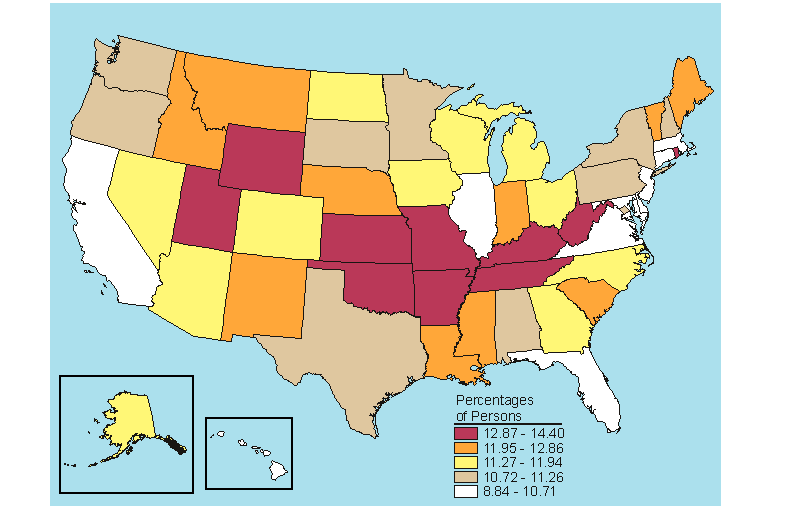
Source: SAMHSA, Office of Applied Studies, National Survey on Drug Use and Health, 2005 and 2006.
Below is a map, click here for the text describing this map.
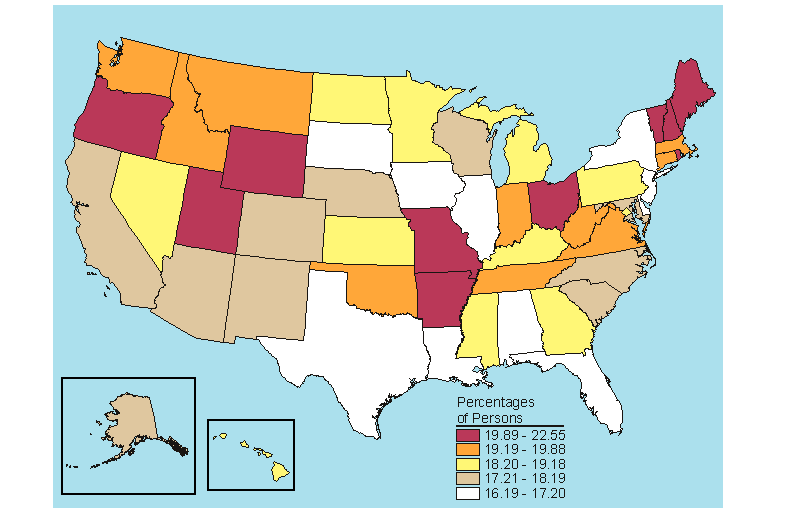
Source: SAMHSA, Office of Applied Studies, National Survey on Drug Use and Health, 2005 and 2006.
Below is a map, click here for the text describing this map.
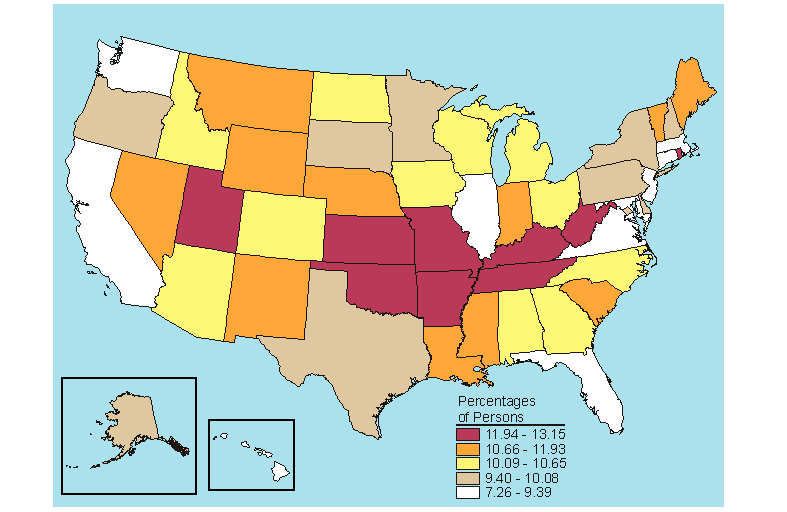
Source: SAMHSA, Office of Applied Studies, National Survey on Drug Use and Health, 2005 and 2006.
Below is a map, click here for the text describing this map.
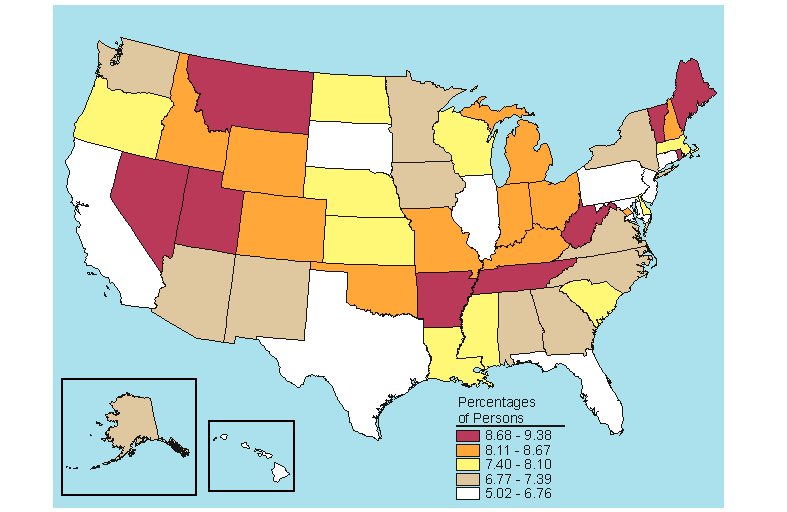
Source: SAMHSA, Office of Applied Studies, National Survey on Drug Use and Health, 2005 and 2006.
Below is a map, click here for the text describing this map.
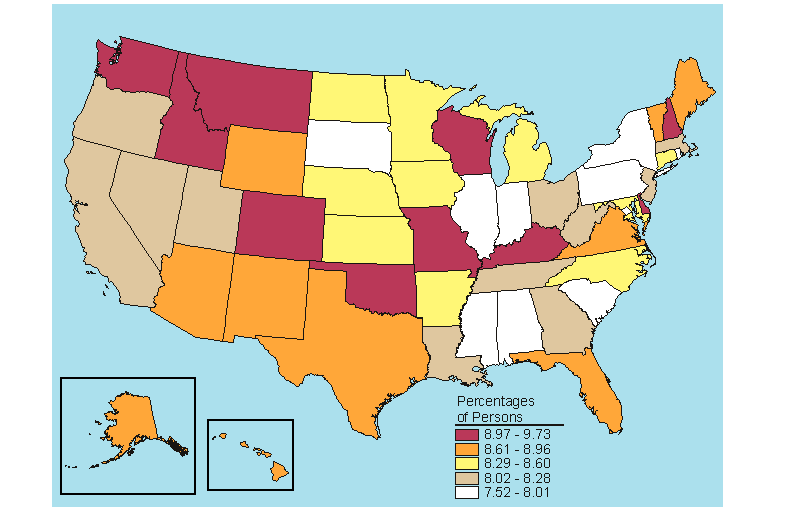
Source: SAMHSA, Office of Applied Studies, National Survey on Drug Use and Health, 2005 and 2006.
Below is a map, click here for the text describing this map.
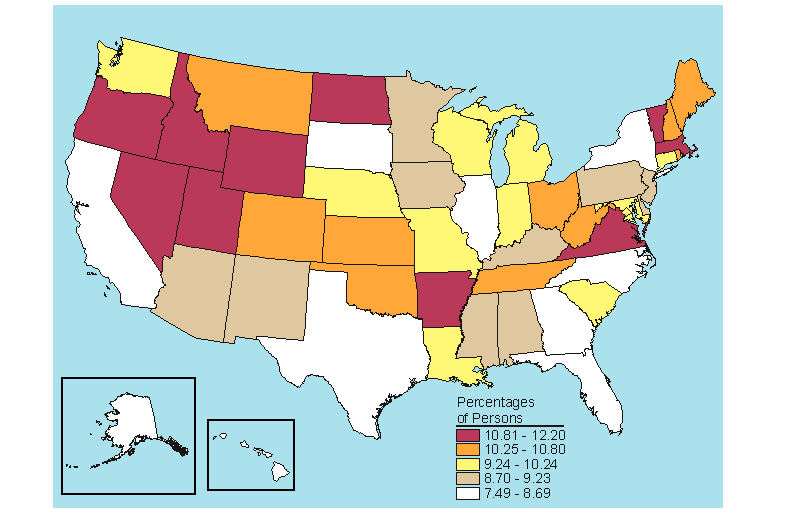
Source: SAMHSA, Office of Applied Studies, National Survey on Drug Use and Health, 2005 and 2006.
Below is a map, click here for the text describing this map.
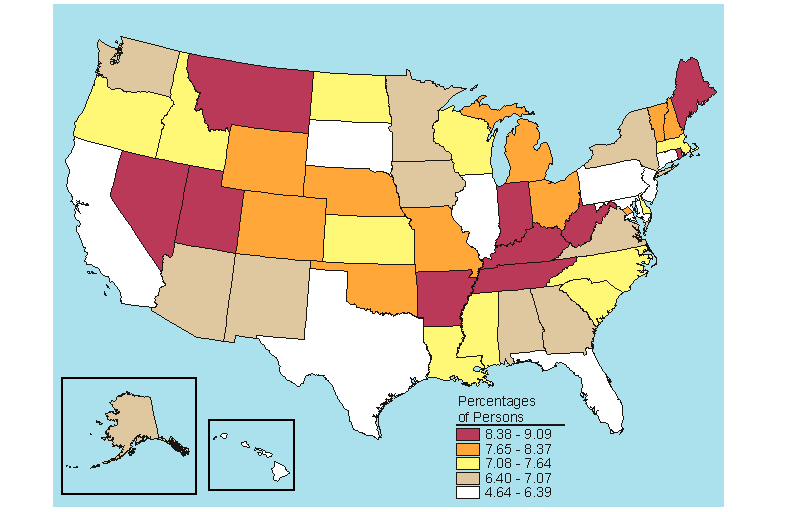
Source: SAMHSA, Office of Applied Studies, National Survey on Drug Use and Health, 2005 and 2006.
|
This page was last updated on December 30, 2008. |
* Adobe™ PDF and MS Office™ formatted files require software viewer programs to properly read them.
Click here to download these FREE programs now
| Highlights | Topics | Data | Drugs | Pubs | Short Reports | Treatment | Help | OAS |